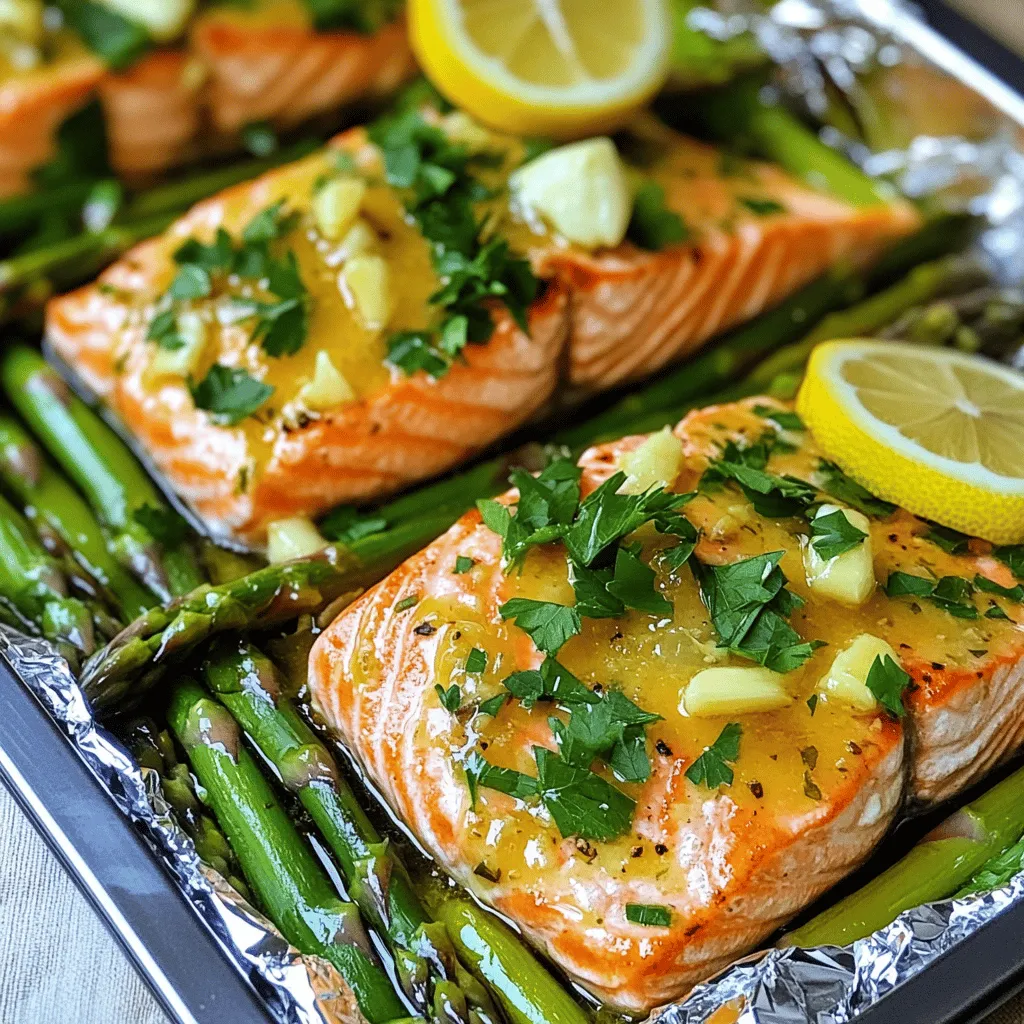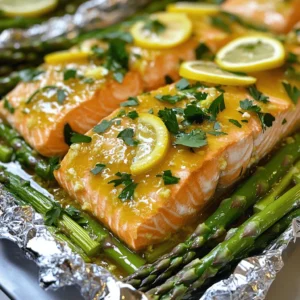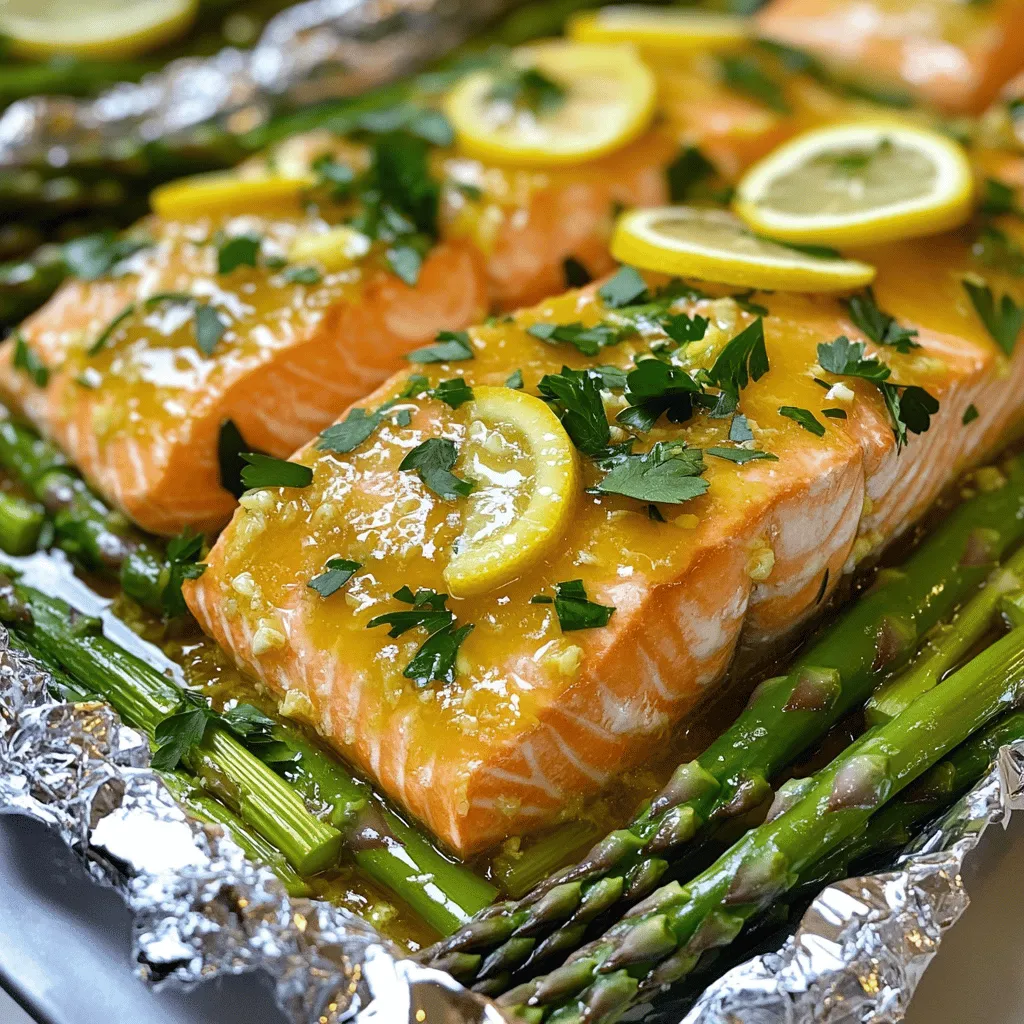Looking for an easy, tasty meal? Try my Baked Salmon in Foil with Asparagus and Lemon Garlic Butter Sauce. It’s a simple, yet flavorful dish that bursts with freshness. Just picture tender salmon, crisp asparagus, and a buttery sauce all wrapped up in foil. Perfect for busy weeknights or a special dinner. Let’s dive into this quick recipe that I know you’ll love!
Ingredients
To make baked salmon in foil with asparagus and lemon garlic butter sauce, gather these ingredients:
– 2 salmon fillets (approximately 6 oz each)
– 1 bunch of fresh asparagus, trimmed and ready for cooking
– 2 tablespoons high-quality olive oil
– 4 tablespoons unsalted butter, melted
– 3 cloves of garlic, minced
– Juice and zest from 1 large lemon
– Sea salt and freshly cracked black pepper
– Fresh parsley, for garnish
– Thin slices of lemon for presentation
These ingredients come together to create a delicious meal that is both easy and quick. The salmon and asparagus provide a healthy balance, while the lemon garlic butter sauce adds a burst of flavor. Each item plays a vital role in enhancing the dish’s overall taste and presentation. Use high-quality ingredients for the best results. For the full recipe, check the complete details above.
Step-by-Step Instructions
Prepping the Oven and Foil
– Preheat the oven to 400°F (200°C).
– Cut a large piece of aluminum foil, about 16 inches long.
Arranging the Salmon and Asparagus
– Lay salmon fillets in the center of the foil.
– Place the asparagus around the salmon.
Making the Lemon Garlic Butter Sauce
– In a bowl, mix melted butter, minced garlic, lemon juice, and zest.
– Add a pinch of salt and pepper to the mixture.
Assembly and Baking
– Pour the sauce over the salmon and asparagus.
– Fold the foil to seal the packet tightly.
Checking for Doneness
– Bake for 15-20 minutes.
– Check if the salmon flakes easily with a fork.
Serving the Dish
– Carefully unwrap the foil packet to avoid steam.
– Garnish with fresh parsley and lemon slices.
For the full recipe, check out the details provided above. Enjoy your delicious meal!
Tips & Tricks
Achieving Perfectly Cooked Salmon
To cook salmon just right, timing and temperature matter. Bake your salmon at 400°F (200°C) for 15 to 20 minutes. The exact time depends on the thickness of your fillets. For best results, check the salmon at the 15-minute mark. It’s done when it flakes easily with a fork. Use a meat thermometer if you have one; the internal temperature should reach 145°F (63°C).
Enhancing Flavor
Want to boost the flavor? Try adding some fresh herbs like dill or thyme. A sprinkle of crushed red pepper can add a nice kick. If you prefer something different, swap garlic for shallots or use lime instead of lemon. These small changes can really transform your dish.
Presentation Techniques
Plating can make your dish stand out. Serve the salmon and asparagus right in the foil for a rustic look. Or, carefully transfer them to a plate. Top with fresh parsley and lemon slices for color. For an extra touch, drizzle a bit of the lemon garlic butter sauce over the top. This adds shine and makes it look gourmet.
For the full recipe, check out the details above!

Variations
Substituting Vegetables
You can swap out asparagus for many tasty veggies. Broccoli, green beans, or zucchini work great. Each brings unique flavors and textures. You can also use seasonal greens like spinach or kale. These add nutrients and color to your dish. Mix and match to find your perfect combo.
Different Sauces
The lemon garlic butter sauce is fantastic, but don’t stop there! Try teriyaki sauce for a sweet and savory twist. Honey mustard adds a nice zing. If you like heat, consider a spicy chili sauce. For a fresh taste, use pesto or an herbed yogurt mix. These sauces can change the meal’s vibe entirely.
Cooking Methods
You can cook this dish in an air fryer or on the grill, too. The air fryer cooks the salmon quickly and evenly. It gives a nice crisp texture without drying out. Grilling adds a smoky flavor that enhances the fish. Both methods are fun and delicious alternatives to baking. They allow you to enjoy the same great taste in different ways.
For more detailed instructions and tips, check the Full Recipe.
Storage Info
Refrigeration Guidelines
To store leftovers, let your baked salmon cool down to room temperature. Then, place it in an airtight container. This keeps it fresh and tasty. I recommend using glass or BPA-free plastic containers. They seal well and won’t retain odors.
Reheating Techniques
The best way to reheat baked salmon is in the oven. Preheat your oven to 275°F (135°C). Place the salmon on a baking dish and cover it with foil. Heat for about 15 minutes, or until warm. This method keeps the salmon moist and flaky. You can also use the microwave, but be careful not to overcook. Heat on low power for short bursts.
Freezing Instructions
To freeze cooked salmon, wrap it tightly in plastic wrap. Then, place it in a freezer bag, removing as much air as possible. This helps prevent freezer burn. It can last up to three months in the freezer. When ready to eat, thaw it overnight in the fridge. After thawing, reheat it using the oven method for the best results.
FAQs
How long does it take to bake salmon in foil?
Baking salmon in foil usually takes about 15 to 20 minutes. The time depends on the thickness of the fillets. For fillets that are 1 inch thick, 15 minutes is often enough. Thicker pieces may need closer to 20 minutes. Always check for flakiness to ensure it’s done.
Can I use frozen salmon for this recipe?
Yes, you can use frozen salmon. Just remember to thaw it first. The best way to thaw is to leave it in the fridge overnight. If you’re short on time, you can also run it under cold water for about an hour. After thawing, pat it dry before cooking to avoid excess moisture.
What temperature should salmon be cooked to?
Salmon should reach an internal temperature of 145°F. This ensures it is safe to eat and still juicy. Use a meat thermometer to check the temperature. When it easily flakes with a fork, it’s usually cooked right.
Can I make this dish ahead of time?
You can prepare it ahead of time. You can assemble the foil packets and store them in the fridge for up to 24 hours. When ready to cook, just pop them in the oven. This makes for an easy weeknight dinner.
What type of salmon is best for baking in foil?
For this recipe, I recommend using wild-caught salmon like sockeye or king. They have a rich flavor and firm texture. Farmed salmon is also a good option, but it may be a bit fattier. Both types work well in foil.
Is this recipe suitable for meal prep?
Absolutely! This recipe is great for meal prep. You can make multiple packets at once. Just divide the cooked salmon and asparagus into containers. They store well in the fridge for about 3 days. Just reheat when you’re ready to eat. Check out the Full Recipe for more details.
This blog post covered a simple and tasty salmon and asparagus recipe. You learned the ingredients, step-by-step instructions, and tips for success. We explored ways to add flavor and variations to suit your taste. You can store and reheat leftovers easily, ensuring no meal goes to waste. Enjoy experimenting with this dish! You have the tools to make it your own, so get cooking and have fun in the kitchen!

